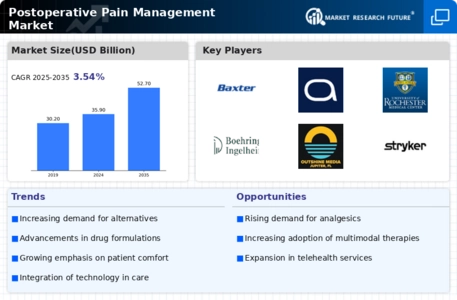-
EXECUTIVE SUMMARY
-
Market Overview
-
Key Findings
-
Market Segmentation
-
Competitive Landscape
-
Challenges and Opportunities
-
Future Outlook
-
MARKET INTRODUCTION
-
Definition
-
Scope of the study
-
Research Objective
-
Assumption
-
Limitations
-
RESEARCH METHODOLOGY
-
Overview
-
Data Mining
-
Secondary Research
-
Primary Research
-
Primary Interviews and Information Gathering Process
-
Breakdown of Primary Respondents
-
Forecasting Model
-
Market Size Estimation
-
Bottom-Up Approach
-
Top-Down Approach
-
Data Triangulation
-
Validation
-
MARKET DYNAMICS
-
Overview
-
Drivers
-
Restraints
-
Opportunities
-
MARKET FACTOR ANALYSIS
-
Value chain Analysis
-
Porter's Five Forces Analysis
-
Bargaining Power of Suppliers
-
Bargaining Power of Buyers
-
Threat of New Entrants
-
Threat of Substitutes
-
Intensity of Rivalry
-
COVID-19 Impact Analysis
-
Market Impact Analysis
-
Regional Impact
-
Opportunity and Threat Analysis
-
Postoperative Pain Management Market, BY Product Type (USD Billion)
-
Analgesics
-
Local Anesthetics
-
Opioids
-
Nonsteroidal Anti-Inflammatory Drugs
-
Adjuvants
-
Postoperative Pain Management Market, BY Administration Route (USD Billion)
-
Oral
-
Intravenous
-
Transdermal
-
Regional
-
Subcutaneous
-
Postoperative Pain Management Market, BY Application (USD Billion)
-
Orthopedic Surgery
-
Cardiothoracic Surgery
-
General Surgery
-
Gynecological Surgery
-
Urological Surgery
-
Postoperative Pain Management Market, BY End User (USD Billion)
-
Hospitals
-
Ambulatory Surgical Centers
-
Home Care Settings
-
Postoperative Pain Management Market, BY Regional (USD Billion)
-
North America
-
US
-
Canada
-
Europe
-
Germany
-
UK
-
France
-
Russia
-
Italy
-
Spain
-
Rest of Europe
-
APAC
-
China
-
India
-
Japan
-
South Korea
-
Malaysia
-
Thailand
-
Indonesia
-
Rest of APAC
-
South America
-
Brazil
-
Mexico
-
Argentina
-
Rest of South America
-
MEA
-
GCC Countries
-
South Africa
-
Rest of MEA
-
Competitive Landscape
-
Overview
-
Competitive Analysis
-
Market share Analysis
-
Major Growth Strategy in the Postoperative Pain Management Market
-
Competitive Benchmarking
-
Leading Players in Terms of Number of Developments in the Postoperative Pain Management Market
-
Key developments and growth strategies
-
New Product Launch/Service Deployment
-
Merger & Acquisitions
-
Joint Ventures
-
Major Players Financial Matrix
-
Sales and Operating Income
-
Major Players R&D Expenditure. 2023
-
Company Profiles
-
Zynerba Pharmaceuticals
-
Financial Overview
-
Products Offered
-
Key Developments
-
SWOT Analysis
-
Key Strategies
-
Baxter International
-
Financial Overview
-
Products Offered
-
Key Developments
-
SWOT Analysis
-
Key Strategies
-
AbbVie
-
Financial Overview
-
Products Offered
-
Key Developments
-
SWOT Analysis
-
Key Strategies
-
Roche
-
Financial Overview
-
Products Offered
-
Key Developments
-
SWOT Analysis
-
Key Strategies
-
Pacira Pharmaceuticals
-
Financial Overview
-
Products Offered
-
Key Developments
-
SWOT Analysis
-
Key Strategies
-
Boehringer Ingelheim
-
Financial Overview
-
Products Offered
-
Key Developments
-
SWOT Analysis
-
Key Strategies
-
Johnson and Johnson
-
Financial Overview
-
Products Offered
-
Key Developments
-
SWOT Analysis
-
Key Strategies
-
Stryker
-
Financial Overview
-
Products Offered
-
Key Developments
-
SWOT Analysis
-
Key Strategies
-
Teleflex
-
Financial Overview
-
Products Offered
-
Key Developments
-
SWOT Analysis
-
Key Strategies
-
Hikma Pharmaceuticals
-
Financial Overview
-
Products Offered
-
Key Developments
-
SWOT Analysis
-
Key Strategies
-
Mylan
-
Financial Overview
-
Products Offered
-
Key Developments
-
SWOT Analysis
-
Key Strategies
-
Purdue Pharma
-
Financial Overview
-
Products Offered
-
Key Developments
-
SWOT Analysis
-
Key Strategies
-
Tornier
-
Financial Overview
-
Products Offered
-
Key Developments
-
SWOT Analysis
-
Key Strategies
-
Appendix
-
References
-
Related Reports
-
LIST Of tables
-
LIST OF ASSUMPTIONS
-
North America Postoperative Pain Management Market SIZE ESTIMATES & FORECAST, BY PRODUCT TYPE, 2019-2035 (USD Billions)
-
North America Postoperative Pain Management Market SIZE ESTIMATES & FORECAST, BY ADMINISTRATION ROUTE, 2019-2035 (USD Billions)
-
North America Postoperative Pain Management Market SIZE ESTIMATES & FORECAST, BY APPLICATION, 2019-2035 (USD Billions)
-
North America Postoperative Pain Management Market SIZE ESTIMATES & FORECAST, BY END USER, 2019-2035 (USD Billions)
-
North America Postoperative Pain Management Market SIZE ESTIMATES & FORECAST, BY REGIONAL, 2019-2035 (USD Billions)
-
US Postoperative Pain Management Market SIZE ESTIMATES & FORECAST, BY PRODUCT TYPE, 2019-2035 (USD Billions)
-
US Postoperative Pain Management Market SIZE ESTIMATES & FORECAST, BY ADMINISTRATION ROUTE, 2019-2035 (USD Billions)
-
US Postoperative Pain Management Market SIZE ESTIMATES & FORECAST, BY APPLICATION, 2019-2035 (USD Billions)
-
US Postoperative Pain Management Market SIZE ESTIMATES & FORECAST, BY END USER, 2019-2035 (USD Billions)
-
US Postoperative Pain Management Market SIZE ESTIMATES & FORECAST, BY REGIONAL, 2019-2035 (USD Billions)
-
Canada Postoperative Pain Management Market SIZE ESTIMATES & FORECAST, BY PRODUCT TYPE, 2019-2035 (USD Billions)
-
Canada Postoperative Pain Management Market SIZE ESTIMATES & FORECAST, BY ADMINISTRATION ROUTE, 2019-2035 (USD Billions)
-
Canada Postoperative Pain Management Market SIZE ESTIMATES & FORECAST, BY APPLICATION, 2019-2035 (USD Billions)
-
Canada Postoperative Pain Management Market SIZE ESTIMATES & FORECAST, BY END USER, 2019-2035 (USD Billions)
-
Canada Postoperative Pain Management Market SIZE ESTIMATES & FORECAST, BY REGIONAL, 2019-2035 (USD Billions)
-
Europe Postoperative Pain Management Market SIZE ESTIMATES & FORECAST, BY PRODUCT TYPE, 2019-2035 (USD Billions)
-
Europe Postoperative Pain Management Market SIZE ESTIMATES & FORECAST, BY ADMINISTRATION ROUTE, 2019-2035 (USD Billions)
-
Europe Postoperative Pain Management Market SIZE ESTIMATES & FORECAST, BY APPLICATION, 2019-2035 (USD Billions)
-
Europe Postoperative Pain Management Market SIZE ESTIMATES & FORECAST, BY END USER, 2019-2035 (USD Billions)
-
Europe Postoperative Pain Management Market SIZE ESTIMATES & FORECAST, BY REGIONAL, 2019-2035 (USD Billions)
-
Germany Postoperative Pain Management Market SIZE ESTIMATES & FORECAST, BY PRODUCT TYPE, 2019-2035 (USD Billions)
-
Germany Postoperative Pain Management Market SIZE ESTIMATES & FORECAST, BY ADMINISTRATION ROUTE, 2019-2035 (USD Billions)
-
Germany Postoperative Pain Management Market SIZE ESTIMATES & FORECAST, BY APPLICATION, 2019-2035 (USD Billions)
-
Germany Postoperative Pain Management Market SIZE ESTIMATES & FORECAST, BY END USER, 2019-2035 (USD Billions)
-
Germany Postoperative Pain Management Market SIZE ESTIMATES & FORECAST, BY REGIONAL, 2019-2035 (USD Billions)
-
UK Postoperative Pain Management Market SIZE ESTIMATES & FORECAST, BY PRODUCT TYPE, 2019-2035 (USD Billions)
-
UK Postoperative Pain Management Market SIZE ESTIMATES & FORECAST, BY ADMINISTRATION ROUTE, 2019-2035 (USD Billions)
-
UK Postoperative Pain Management Market SIZE ESTIMATES & FORECAST, BY APPLICATION, 2019-2035 (USD Billions)
-
UK Postoperative Pain Management Market SIZE ESTIMATES & FORECAST, BY END USER, 2019-2035 (USD Billions)
-
UK Postoperative Pain Management Market SIZE ESTIMATES & FORECAST, BY REGIONAL, 2019-2035 (USD Billions)
-
France Postoperative Pain Management Market SIZE ESTIMATES & FORECAST, BY PRODUCT TYPE, 2019-2035 (USD Billions)
-
France Postoperative Pain Management Market SIZE ESTIMATES & FORECAST, BY ADMINISTRATION ROUTE, 2019-2035 (USD Billions)
-
France Postoperative Pain Management Market SIZE ESTIMATES & FORECAST, BY APPLICATION, 2019-2035 (USD Billions)
-
France Postoperative Pain Management Market SIZE ESTIMATES & FORECAST, BY END USER, 2019-2035 (USD Billions)
-
France Postoperative Pain Management Market SIZE ESTIMATES & FORECAST, BY REGIONAL, 2019-2035 (USD Billions)
-
Russia Postoperative Pain Management Market SIZE ESTIMATES & FORECAST, BY PRODUCT TYPE, 2019-2035 (USD Billions)
-
Russia Postoperative Pain Management Market SIZE ESTIMATES & FORECAST, BY ADMINISTRATION ROUTE, 2019-2035 (USD Billions)
-
Russia Postoperative Pain Management Market SIZE ESTIMATES & FORECAST, BY APPLICATION, 2019-2035 (USD Billions)
-
Russia Postoperative Pain Management Market SIZE ESTIMATES & FORECAST, BY END USER, 2019-2035 (USD Billions)
-
Russia Postoperative Pain Management Market SIZE ESTIMATES & FORECAST, BY REGIONAL, 2019-2035 (USD Billions)
-
Italy Postoperative Pain Management Market SIZE ESTIMATES & FORECAST, BY PRODUCT TYPE, 2019-2035 (USD Billions)
-
Italy Postoperative Pain Management Market SIZE ESTIMATES & FORECAST, BY ADMINISTRATION ROUTE, 2019-2035 (USD Billions)
-
Italy Postoperative Pain Management Market SIZE ESTIMATES & FORECAST, BY APPLICATION, 2019-2035 (USD Billions)
-
Italy Postoperative Pain Management Market SIZE ESTIMATES & FORECAST, BY END USER, 2019-2035 (USD Billions)
-
Italy Postoperative Pain Management Market SIZE ESTIMATES & FORECAST, BY REGIONAL, 2019-2035 (USD Billions)
-
Spain Postoperative Pain Management Market SIZE ESTIMATES & FORECAST, BY PRODUCT TYPE, 2019-2035 (USD Billions)
-
Spain Postoperative Pain Management Market SIZE ESTIMATES & FORECAST, BY ADMINISTRATION ROUTE, 2019-2035 (USD Billions)
-
Spain Postoperative Pain Management Market SIZE ESTIMATES & FORECAST, BY APPLICATION, 2019-2035 (USD Billions)
-
Spain Postoperative Pain Management Market SIZE ESTIMATES & FORECAST, BY END USER, 2019-2035 (USD Billions)
-
Spain Postoperative Pain Management Market SIZE ESTIMATES & FORECAST, BY REGIONAL, 2019-2035 (USD Billions)
-
Rest of Europe Postoperative Pain Management Market SIZE ESTIMATES & FORECAST, BY PRODUCT TYPE, 2019-2035 (USD Billions)
-
Rest of Europe Postoperative Pain Management Market SIZE ESTIMATES & FORECAST, BY ADMINISTRATION ROUTE, 2019-2035 (USD Billions)
-
Rest of Europe Postoperative Pain Management Market SIZE ESTIMATES & FORECAST, BY APPLICATION, 2019-2035 (USD Billions)
-
Rest of Europe Postoperative Pain Management Market SIZE ESTIMATES & FORECAST, BY END USER, 2019-2035 (USD Billions)
-
Rest of Europe Postoperative Pain Management Market SIZE ESTIMATES & FORECAST, BY REGIONAL, 2019-2035 (USD Billions)
-
APAC Postoperative Pain Management Market SIZE ESTIMATES & FORECAST, BY PRODUCT TYPE, 2019-2035 (USD Billions)
-
APAC Postoperative Pain Management Market SIZE ESTIMATES & FORECAST, BY ADMINISTRATION ROUTE, 2019-2035 (USD Billions)
-
APAC Postoperative Pain Management Market SIZE ESTIMATES & FORECAST, BY APPLICATION, 2019-2035 (USD Billions)
-
APAC Postoperative Pain Management Market SIZE ESTIMATES & FORECAST, BY END USER, 2019-2035 (USD Billions)
-
APAC Postoperative Pain Management Market SIZE ESTIMATES & FORECAST, BY REGIONAL, 2019-2035 (USD Billions)
-
China Postoperative Pain Management Market SIZE ESTIMATES & FORECAST, BY PRODUCT TYPE, 2019-2035 (USD Billions)
-
China Postoperative Pain Management Market SIZE ESTIMATES & FORECAST, BY ADMINISTRATION ROUTE, 2019-2035 (USD Billions)
-
China Postoperative Pain Management Market SIZE ESTIMATES & FORECAST, BY APPLICATION, 2019-2035 (USD Billions)
-
China Postoperative Pain Management Market SIZE ESTIMATES & FORECAST, BY END USER, 2019-2035 (USD Billions)
-
China Postoperative Pain Management Market SIZE ESTIMATES & FORECAST, BY REGIONAL, 2019-2035 (USD Billions)
-
India Postoperative Pain Management Market SIZE ESTIMATES & FORECAST, BY PRODUCT TYPE, 2019-2035 (USD Billions)
-
India Postoperative Pain Management Market SIZE ESTIMATES & FORECAST, BY ADMINISTRATION ROUTE, 2019-2035 (USD Billions)
-
India Postoperative Pain Management Market SIZE ESTIMATES & FORECAST, BY APPLICATION, 2019-2035 (USD Billions)
-
India Postoperative Pain Management Market SIZE ESTIMATES & FORECAST, BY END USER, 2019-2035 (USD Billions)
-
India Postoperative Pain Management Market SIZE ESTIMATES & FORECAST, BY REGIONAL, 2019-2035 (USD Billions)
-
Japan Postoperative Pain Management Market SIZE ESTIMATES & FORECAST, BY PRODUCT TYPE, 2019-2035 (USD Billions)
-
Japan Postoperative Pain Management Market SIZE ESTIMATES & FORECAST, BY ADMINISTRATION ROUTE, 2019-2035 (USD Billions)
-
Japan Postoperative Pain Management Market SIZE ESTIMATES & FORECAST, BY APPLICATION, 2019-2035 (USD Billions)
-
Japan Postoperative Pain Management Market SIZE ESTIMATES & FORECAST, BY END USER, 2019-2035 (USD Billions)
-
Japan Postoperative Pain Management Market SIZE ESTIMATES & FORECAST, BY REGIONAL, 2019-2035 (USD Billions)
-
South Korea Postoperative Pain Management Market SIZE ESTIMATES & FORECAST, BY PRODUCT TYPE, 2019-2035 (USD Billions)
-
South Korea Postoperative Pain Management Market SIZE ESTIMATES & FORECAST, BY ADMINISTRATION ROUTE, 2019-2035 (USD Billions)
-
South Korea Postoperative Pain Management Market SIZE ESTIMATES & FORECAST, BY APPLICATION, 2019-2035 (USD Billions)
-
South Korea Postoperative Pain Management Market SIZE ESTIMATES & FORECAST, BY END USER, 2019-2035 (USD Billions)
-
South Korea Postoperative Pain Management Market SIZE ESTIMATES & FORECAST, BY REGIONAL, 2019-2035 (USD Billions)
-
Malaysia Postoperative Pain Management Market SIZE ESTIMATES & FORECAST, BY PRODUCT TYPE, 2019-2035 (USD Billions)
-
Malaysia Postoperative Pain Management Market SIZE ESTIMATES & FORECAST, BY ADMINISTRATION ROUTE, 2019-2035 (USD Billions)
-
Malaysia Postoperative Pain Management Market SIZE ESTIMATES & FORECAST, BY APPLICATION, 2019-2035 (USD Billions)
-
Malaysia Postoperative Pain Management Market SIZE ESTIMATES & FORECAST, BY END USER, 2019-2035 (USD Billions)
-
Malaysia Postoperative Pain Management Market SIZE ESTIMATES & FORECAST, BY REGIONAL, 2019-2035 (USD Billions)
-
Thailand Postoperative Pain Management Market SIZE ESTIMATES & FORECAST, BY PRODUCT TYPE, 2019-2035 (USD Billions)
-
Thailand Postoperative Pain Management Market SIZE ESTIMATES & FORECAST, BY ADMINISTRATION ROUTE, 2019-2035 (USD Billions)
-
Thailand Postoperative Pain Management Market SIZE ESTIMATES & FORECAST, BY APPLICATION, 2019-2035 (USD Billions)
-
Thailand Postoperative Pain Management Market SIZE ESTIMATES & FORECAST, BY END USER, 2019-2035 (USD Billions)
-
Thailand Postoperative Pain Management Market SIZE ESTIMATES & FORECAST, BY REGIONAL, 2019-2035 (USD Billions)
-
Indonesia Postoperative Pain Management Market SIZE ESTIMATES & FORECAST, BY PRODUCT TYPE, 2019-2035 (USD Billions)
-
Indonesia Postoperative Pain Management Market SIZE ESTIMATES & FORECAST, BY ADMINISTRATION ROUTE, 2019-2035 (USD Billions)
-
Indonesia Postoperative Pain Management Market SIZE ESTIMATES & FORECAST, BY APPLICATION, 2019-2035 (USD Billions)
-
Indonesia Postoperative Pain Management Market SIZE ESTIMATES & FORECAST, BY END USER, 2019-2035 (USD Billions)
-
Indonesia Postoperative Pain Management Market SIZE ESTIMATES & FORECAST, BY REGIONAL, 2019-2035 (USD Billions)
-
Rest of APAC Postoperative Pain Management Market SIZE ESTIMATES & FORECAST, BY PRODUCT TYPE, 2019-2035 (USD Billions)
-
Rest of APAC Postoperative Pain Management Market SIZE ESTIMATES & FORECAST, BY ADMINISTRATION ROUTE, 2019-2035 (USD Billions)
-
Rest of APAC Postoperative Pain Management Market SIZE ESTIMATES & FORECAST, BY APPLICATION, 2019-2035 (USD Billions)
-
Rest of APAC Postoperative Pain Management Market SIZE ESTIMATES & FORECAST, BY END USER, 2019-2035 (USD Billions)
-
Rest of APAC Postoperative Pain Management Market SIZE ESTIMATES & FORECAST, BY REGIONAL, 2019-2035 (USD Billions)
-
South America Postoperative Pain Management Market SIZE ESTIMATES & FORECAST, BY PRODUCT TYPE, 2019-2035 (USD Billions)
-
South America Postoperative Pain Management Market SIZE ESTIMATES & FORECAST, BY ADMINISTRATION ROUTE, 2019-2035 (USD Billions)
-
South America Postoperative Pain Management Market SIZE ESTIMATES & FORECAST, BY APPLICATION, 2019-2035 (USD Billions)
-
South America Postoperative Pain Management Market SIZE ESTIMATES & FORECAST, BY END USER, 2019-2035 (USD Billions)
-
South America Postoperative Pain Management Market SIZE ESTIMATES & FORECAST, BY REGIONAL, 2019-2035 (USD Billions)
-
Brazil Postoperative Pain Management Market SIZE ESTIMATES & FORECAST, BY PRODUCT TYPE, 2019-2035 (USD Billions)
-
Brazil Postoperative Pain Management Market SIZE ESTIMATES & FORECAST, BY ADMINISTRATION ROUTE, 2019-2035 (USD Billions)
-
Brazil Postoperative Pain Management Market SIZE ESTIMATES & FORECAST, BY APPLICATION, 2019-2035 (USD Billions)
-
Brazil Postoperative Pain Management Market SIZE ESTIMATES & FORECAST, BY END USER, 2019-2035 (USD Billions)
-
Brazil Postoperative Pain Management Market SIZE ESTIMATES & FORECAST, BY REGIONAL, 2019-2035 (USD Billions)
-
Mexico Postoperative Pain Management Market SIZE ESTIMATES & FORECAST, BY PRODUCT TYPE, 2019-2035 (USD Billions)
-
Mexico Postoperative Pain Management Market SIZE ESTIMATES & FORECAST, BY ADMINISTRATION ROUTE, 2019-2035 (USD Billions)
-
Mexico Postoperative Pain Management Market SIZE ESTIMATES & FORECAST, BY APPLICATION, 2019-2035 (USD Billions)
-
Mexico Postoperative Pain Management Market SIZE ESTIMATES & FORECAST, BY END USER, 2019-2035 (USD Billions)
-
Mexico Postoperative Pain Management Market SIZE ESTIMATES & FORECAST, BY REGIONAL, 2019-2035 (USD Billions)
-
Argentina Postoperative Pain Management Market SIZE ESTIMATES & FORECAST, BY PRODUCT TYPE, 2019-2035 (USD Billions)
-
Argentina Postoperative Pain Management Market SIZE ESTIMATES & FORECAST, BY ADMINISTRATION ROUTE, 2019-2035 (USD Billions)
-
Argentina Postoperative Pain Management Market SIZE ESTIMATES & FORECAST, BY APPLICATION, 2019-2035 (USD Billions)
-
Argentina Postoperative Pain Management Market SIZE ESTIMATES & FORECAST, BY END USER, 2019-2035 (USD Billions)
-
Argentina Postoperative Pain Management Market SIZE ESTIMATES & FORECAST, BY REGIONAL, 2019-2035 (USD Billions)
-
Rest of South America Postoperative Pain Management Market SIZE ESTIMATES & FORECAST, BY PRODUCT TYPE, 2019-2035 (USD Billions)
-
Rest of South America Postoperative Pain Management Market SIZE ESTIMATES & FORECAST, BY ADMINISTRATION ROUTE, 2019-2035 (USD Billions)
-
Rest of South America Postoperative Pain Management Market SIZE ESTIMATES & FORECAST, BY APPLICATION, 2019-2035 (USD Billions)
-
Rest of South America Postoperative Pain Management Market SIZE ESTIMATES & FORECAST, BY END USER, 2019-2035 (USD Billions)
-
Rest of South America Postoperative Pain Management Market SIZE ESTIMATES & FORECAST, BY REGIONAL, 2019-2035 (USD Billions)
-
MEA Postoperative Pain Management Market SIZE ESTIMATES & FORECAST, BY PRODUCT TYPE, 2019-2035 (USD Billions)
-
MEA Postoperative Pain Management Market SIZE ESTIMATES & FORECAST, BY ADMINISTRATION ROUTE, 2019-2035 (USD Billions)
-
MEA Postoperative Pain Management Market SIZE ESTIMATES & FORECAST, BY APPLICATION, 2019-2035 (USD Billions)
-
MEA Postoperative Pain Management Market SIZE ESTIMATES & FORECAST, BY END USER, 2019-2035 (USD Billions)
-
MEA Postoperative Pain Management Market SIZE ESTIMATES & FORECAST, BY REGIONAL, 2019-2035 (USD Billions)
-
GCC Countries Postoperative Pain Management Market SIZE ESTIMATES & FORECAST, BY PRODUCT TYPE, 2019-2035 (USD Billions)
-
GCC Countries Postoperative Pain Management Market SIZE ESTIMATES & FORECAST, BY ADMINISTRATION ROUTE, 2019-2035 (USD Billions)
-
GCC Countries Postoperative Pain Management Market SIZE ESTIMATES & FORECAST, BY APPLICATION, 2019-2035 (USD Billions)
-
GCC Countries Postoperative Pain Management Market SIZE ESTIMATES & FORECAST, BY END USER, 2019-2035 (USD Billions)
-
GCC Countries Postoperative Pain Management Market SIZE ESTIMATES & FORECAST, BY REGIONAL, 2019-2035 (USD Billions)
-
South Africa Postoperative Pain Management Market SIZE ESTIMATES & FORECAST, BY PRODUCT TYPE, 2019-2035 (USD Billions)
-
South Africa Postoperative Pain Management Market SIZE ESTIMATES & FORECAST, BY ADMINISTRATION ROUTE, 2019-2035 (USD Billions)
-
South Africa Postoperative Pain Management Market SIZE ESTIMATES & FORECAST, BY APPLICATION, 2019-2035 (USD Billions)
-
South Africa Postoperative Pain Management Market SIZE ESTIMATES & FORECAST, BY END USER, 2019-2035 (USD Billions)
-
South Africa Postoperative Pain Management Market SIZE ESTIMATES & FORECAST, BY REGIONAL, 2019-2035 (USD Billions)
-
Rest of MEA Postoperative Pain Management Market SIZE ESTIMATES & FORECAST, BY PRODUCT TYPE, 2019-2035 (USD Billions)
-
Rest of MEA Postoperative Pain Management Market SIZE ESTIMATES & FORECAST, BY ADMINISTRATION ROUTE, 2019-2035 (USD Billions)
-
Rest of MEA Postoperative Pain Management Market SIZE ESTIMATES & FORECAST, BY APPLICATION, 2019-2035 (USD Billions)
-
Rest of MEA Postoperative Pain Management Market SIZE ESTIMATES & FORECAST, BY END USER, 2019-2035 (USD Billions)
-
Rest of MEA Postoperative Pain Management Market SIZE ESTIMATES & FORECAST, BY REGIONAL, 2019-2035 (USD Billions)
-
PRODUCT LAUNCH/PRODUCT DEVELOPMENT/APPROVAL
-
ACQUISITION/PARTNERSHIP
-
LIST Of figures
-
MARKET SYNOPSIS
-
NORTH AMERICA POSTOPERATIVE PAIN MANAGEMENT MARKET ANALYSIS
-
US POSTOPERATIVE PAIN MANAGEMENT MARKET ANALYSIS BY PRODUCT TYPE
-
US POSTOPERATIVE PAIN MANAGEMENT MARKET ANALYSIS BY ADMINISTRATION ROUTE
-
US POSTOPERATIVE PAIN MANAGEMENT MARKET ANALYSIS BY APPLICATION
-
US POSTOPERATIVE PAIN MANAGEMENT MARKET ANALYSIS BY END USER
-
US POSTOPERATIVE PAIN MANAGEMENT MARKET ANALYSIS BY REGIONAL
-
CANADA POSTOPERATIVE PAIN MANAGEMENT MARKET ANALYSIS BY PRODUCT TYPE
-
CANADA POSTOPERATIVE PAIN MANAGEMENT MARKET ANALYSIS BY ADMINISTRATION ROUTE
-
CANADA POSTOPERATIVE PAIN MANAGEMENT MARKET ANALYSIS BY APPLICATION
-
CANADA POSTOPERATIVE PAIN MANAGEMENT MARKET ANALYSIS BY END USER
-
CANADA POSTOPERATIVE PAIN MANAGEMENT MARKET ANALYSIS BY REGIONAL
-
EUROPE POSTOPERATIVE PAIN MANAGEMENT MARKET ANALYSIS
-
GERMANY POSTOPERATIVE PAIN MANAGEMENT MARKET ANALYSIS BY PRODUCT TYPE
-
GERMANY POSTOPERATIVE PAIN MANAGEMENT MARKET ANALYSIS BY ADMINISTRATION ROUTE
-
GERMANY POSTOPERATIVE PAIN MANAGEMENT MARKET ANALYSIS BY APPLICATION
-
GERMANY POSTOPERATIVE PAIN MANAGEMENT MARKET ANALYSIS BY END USER
-
GERMANY POSTOPERATIVE PAIN MANAGEMENT MARKET ANALYSIS BY REGIONAL
-
UK POSTOPERATIVE PAIN MANAGEMENT MARKET ANALYSIS BY PRODUCT TYPE
-
UK POSTOPERATIVE PAIN MANAGEMENT MARKET ANALYSIS BY ADMINISTRATION ROUTE
-
UK POSTOPERATIVE PAIN MANAGEMENT MARKET ANALYSIS BY APPLICATION
-
UK POSTOPERATIVE PAIN MANAGEMENT MARKET ANALYSIS BY END USER
-
UK POSTOPERATIVE PAIN MANAGEMENT MARKET ANALYSIS BY REGIONAL
-
FRANCE POSTOPERATIVE PAIN MANAGEMENT MARKET ANALYSIS BY PRODUCT TYPE
-
FRANCE POSTOPERATIVE PAIN MANAGEMENT MARKET ANALYSIS BY ADMINISTRATION ROUTE
-
FRANCE POSTOPERATIVE PAIN MANAGEMENT MARKET ANALYSIS BY APPLICATION
-
FRANCE POSTOPERATIVE PAIN MANAGEMENT MARKET ANALYSIS BY END USER
-
FRANCE POSTOPERATIVE PAIN MANAGEMENT MARKET ANALYSIS BY REGIONAL
-
RUSSIA POSTOPERATIVE PAIN MANAGEMENT MARKET ANALYSIS BY PRODUCT TYPE
-
RUSSIA POSTOPERATIVE PAIN MANAGEMENT MARKET ANALYSIS BY ADMINISTRATION ROUTE
-
RUSSIA POSTOPERATIVE PAIN MANAGEMENT MARKET ANALYSIS BY APPLICATION
-
RUSSIA POSTOPERATIVE PAIN MANAGEMENT MARKET ANALYSIS BY END USER
-
RUSSIA POSTOPERATIVE PAIN MANAGEMENT MARKET ANALYSIS BY REGIONAL
-
ITALY POSTOPERATIVE PAIN MANAGEMENT MARKET ANALYSIS BY PRODUCT TYPE
-
ITALY POSTOPERATIVE PAIN MANAGEMENT MARKET ANALYSIS BY ADMINISTRATION ROUTE
-
ITALY POSTOPERATIVE PAIN MANAGEMENT MARKET ANALYSIS BY APPLICATION
-
ITALY POSTOPERATIVE PAIN MANAGEMENT MARKET ANALYSIS BY END USER
-
ITALY POSTOPERATIVE PAIN MANAGEMENT MARKET ANALYSIS BY REGIONAL
-
SPAIN POSTOPERATIVE PAIN MANAGEMENT MARKET ANALYSIS BY PRODUCT TYPE
-
SPAIN POSTOPERATIVE PAIN MANAGEMENT MARKET ANALYSIS BY ADMINISTRATION ROUTE
-
SPAIN POSTOPERATIVE PAIN MANAGEMENT MARKET ANALYSIS BY APPLICATION
-
SPAIN POSTOPERATIVE PAIN MANAGEMENT MARKET ANALYSIS BY END USER
-
SPAIN POSTOPERATIVE PAIN MANAGEMENT MARKET ANALYSIS BY REGIONAL
-
REST OF EUROPE POSTOPERATIVE PAIN MANAGEMENT MARKET ANALYSIS BY PRODUCT TYPE
-
REST OF EUROPE POSTOPERATIVE PAIN MANAGEMENT MARKET ANALYSIS BY ADMINISTRATION ROUTE
-
REST OF EUROPE POSTOPERATIVE PAIN MANAGEMENT MARKET ANALYSIS BY APPLICATION
-
REST OF EUROPE POSTOPERATIVE PAIN MANAGEMENT MARKET ANALYSIS BY END USER
-
REST OF EUROPE POSTOPERATIVE PAIN MANAGEMENT MARKET ANALYSIS BY REGIONAL
-
APAC POSTOPERATIVE PAIN MANAGEMENT MARKET ANALYSIS
-
CHINA POSTOPERATIVE PAIN MANAGEMENT MARKET ANALYSIS BY PRODUCT TYPE
-
CHINA POSTOPERATIVE PAIN MANAGEMENT MARKET ANALYSIS BY ADMINISTRATION ROUTE
-
CHINA POSTOPERATIVE PAIN MANAGEMENT MARKET ANALYSIS BY APPLICATION
-
CHINA POSTOPERATIVE PAIN MANAGEMENT MARKET ANALYSIS BY END USER
-
CHINA POSTOPERATIVE PAIN MANAGEMENT MARKET ANALYSIS BY REGIONAL
-
INDIA POSTOPERATIVE PAIN MANAGEMENT MARKET ANALYSIS BY PRODUCT TYPE
-
INDIA POSTOPERATIVE PAIN MANAGEMENT MARKET ANALYSIS BY ADMINISTRATION ROUTE
-
INDIA POSTOPERATIVE PAIN MANAGEMENT MARKET ANALYSIS BY APPLICATION
-
INDIA POSTOPERATIVE PAIN MANAGEMENT MARKET ANALYSIS BY END USER
-
INDIA POSTOPERATIVE PAIN MANAGEMENT MARKET ANALYSIS BY REGIONAL
-
JAPAN POSTOPERATIVE PAIN MANAGEMENT MARKET ANALYSIS BY PRODUCT TYPE
-
JAPAN POSTOPERATIVE PAIN MANAGEMENT MARKET ANALYSIS BY ADMINISTRATION ROUTE
-
JAPAN POSTOPERATIVE PAIN MANAGEMENT MARKET ANALYSIS BY APPLICATION
-
JAPAN POSTOPERATIVE PAIN MANAGEMENT MARKET ANALYSIS BY END USER
-
JAPAN POSTOPERATIVE PAIN MANAGEMENT MARKET ANALYSIS BY REGIONAL
-
SOUTH KOREA POSTOPERATIVE PAIN MANAGEMENT MARKET ANALYSIS BY PRODUCT TYPE
-
SOUTH KOREA POSTOPERATIVE PAIN MANAGEMENT MARKET ANALYSIS BY ADMINISTRATION ROUTE
-
SOUTH KOREA POSTOPERATIVE PAIN MANAGEMENT MARKET ANALYSIS BY APPLICATION
-
SOUTH KOREA POSTOPERATIVE PAIN MANAGEMENT MARKET ANALYSIS BY END USER
-
SOUTH KOREA POSTOPERATIVE PAIN MANAGEMENT MARKET ANALYSIS BY REGIONAL
-
MALAYSIA POSTOPERATIVE PAIN MANAGEMENT MARKET ANALYSIS BY PRODUCT TYPE
-
MALAYSIA POSTOPERATIVE PAIN MANAGEMENT MARKET ANALYSIS BY ADMINISTRATION ROUTE
-
MALAYSIA POSTOPERATIVE PAIN MANAGEMENT MARKET ANALYSIS BY APPLICATION
-
MALAYSIA POSTOPERATIVE PAIN MANAGEMENT MARKET ANALYSIS BY END USER
-
MALAYSIA POSTOPERATIVE PAIN MANAGEMENT MARKET ANALYSIS BY REGIONAL
-
THAILAND POSTOPERATIVE PAIN MANAGEMENT MARKET ANALYSIS BY PRODUCT TYPE
-
THAILAND POSTOPERATIVE PAIN MANAGEMENT MARKET ANALYSIS BY ADMINISTRATION ROUTE
-
THAILAND POSTOPERATIVE PAIN MANAGEMENT MARKET ANALYSIS BY APPLICATION
-
THAILAND POSTOPERATIVE PAIN MANAGEMENT MARKET ANALYSIS BY END USER
-
THAILAND POSTOPERATIVE PAIN MANAGEMENT MARKET ANALYSIS BY REGIONAL
-
INDONESIA POSTOPERATIVE PAIN MANAGEMENT MARKET ANALYSIS BY PRODUCT TYPE
-
INDONESIA POSTOPERATIVE PAIN MANAGEMENT MARKET ANALYSIS BY ADMINISTRATION ROUTE
-
INDONESIA POSTOPERATIVE PAIN MANAGEMENT MARKET ANALYSIS BY APPLICATION
-
INDONESIA POSTOPERATIVE PAIN MANAGEMENT MARKET ANALYSIS BY END USER
-
INDONESIA POSTOPERATIVE PAIN MANAGEMENT MARKET ANALYSIS BY REGIONAL
-
REST OF APAC POSTOPERATIVE PAIN MANAGEMENT MARKET ANALYSIS BY PRODUCT TYPE
-
REST OF APAC POSTOPERATIVE PAIN MANAGEMENT MARKET ANALYSIS BY ADMINISTRATION ROUTE
-
REST OF APAC POSTOPERATIVE PAIN MANAGEMENT MARKET ANALYSIS BY APPLICATION
-
REST OF APAC POSTOPERATIVE PAIN MANAGEMENT MARKET ANALYSIS BY END USER
-
REST OF APAC POSTOPERATIVE PAIN MANAGEMENT MARKET ANALYSIS BY REGIONAL
-
SOUTH AMERICA POSTOPERATIVE PAIN MANAGEMENT MARKET ANALYSIS
-
BRAZIL POSTOPERATIVE PAIN MANAGEMENT MARKET ANALYSIS BY PRODUCT TYPE
-
BRAZIL POSTOPERATIVE PAIN MANAGEMENT MARKET ANALYSIS BY ADMINISTRATION ROUTE
-
BRAZIL POSTOPERATIVE PAIN MANAGEMENT MARKET ANALYSIS BY APPLICATION
-
BRAZIL POSTOPERATIVE PAIN MANAGEMENT MARKET ANALYSIS BY END USER
-
BRAZIL POSTOPERATIVE PAIN MANAGEMENT MARKET ANALYSIS BY REGIONAL
-
MEXICO POSTOPERATIVE PAIN MANAGEMENT MARKET ANALYSIS BY PRODUCT TYPE
-
MEXICO POSTOPERATIVE PAIN MANAGEMENT MARKET ANALYSIS BY ADMINISTRATION ROUTE
-
MEXICO POSTOPERATIVE PAIN MANAGEMENT MARKET ANALYSIS BY APPLICATION
-
MEXICO POSTOPERATIVE PAIN MANAGEMENT MARKET ANALYSIS BY END USER
-
MEXICO POSTOPERATIVE PAIN MANAGEMENT MARKET ANALYSIS BY REGIONAL
-
ARGENTINA POSTOPERATIVE PAIN MANAGEMENT MARKET ANALYSIS BY PRODUCT TYPE
-
ARGENTINA POSTOPERATIVE PAIN MANAGEMENT MARKET ANALYSIS BY ADMINISTRATION ROUTE
-
ARGENTINA POSTOPERATIVE PAIN MANAGEMENT MARKET ANALYSIS BY APPLICATION
-
ARGENTINA POSTOPERATIVE PAIN MANAGEMENT MARKET ANALYSIS BY END USER
-
ARGENTINA POSTOPERATIVE PAIN MANAGEMENT MARKET ANALYSIS BY REGIONAL
-
REST OF SOUTH AMERICA POSTOPERATIVE PAIN MANAGEMENT MARKET ANALYSIS BY PRODUCT TYPE
-
REST OF SOUTH AMERICA POSTOPERATIVE PAIN MANAGEMENT MARKET ANALYSIS BY ADMINISTRATION ROUTE
-
REST OF SOUTH AMERICA POSTOPERATIVE PAIN MANAGEMENT MARKET ANALYSIS BY APPLICATION
-
REST OF SOUTH AMERICA POSTOPERATIVE PAIN MANAGEMENT MARKET ANALYSIS BY END USER
-
REST OF SOUTH AMERICA POSTOPERATIVE PAIN MANAGEMENT MARKET ANALYSIS BY REGIONAL
-
MEA POSTOPERATIVE PAIN MANAGEMENT MARKET ANALYSIS
-
GCC COUNTRIES POSTOPERATIVE PAIN MANAGEMENT MARKET ANALYSIS BY PRODUCT TYPE
-
GCC COUNTRIES POSTOPERATIVE PAIN MANAGEMENT MARKET ANALYSIS BY ADMINISTRATION ROUTE
-
GCC COUNTRIES POSTOPERATIVE PAIN MANAGEMENT MARKET ANALYSIS BY APPLICATION
-
GCC COUNTRIES POSTOPERATIVE PAIN MANAGEMENT MARKET ANALYSIS BY END USER
-
GCC COUNTRIES POSTOPERATIVE PAIN MANAGEMENT MARKET ANALYSIS BY REGIONAL
-
SOUTH AFRICA POSTOPERATIVE PAIN MANAGEMENT MARKET ANALYSIS BY PRODUCT TYPE
-
SOUTH AFRICA POSTOPERATIVE PAIN MANAGEMENT MARKET ANALYSIS BY ADMINISTRATION ROUTE
-
SOUTH AFRICA POSTOPERATIVE PAIN MANAGEMENT MARKET ANALYSIS BY APPLICATION
-
SOUTH AFRICA POSTOPERATIVE PAIN MANAGEMENT MARKET ANALYSIS BY END USER
-
SOUTH AFRICA POSTOPERATIVE PAIN MANAGEMENT MARKET ANALYSIS BY REGIONAL
-
REST OF MEA POSTOPERATIVE PAIN MANAGEMENT MARKET ANALYSIS BY PRODUCT TYPE
-
REST OF MEA POSTOPERATIVE PAIN MANAGEMENT MARKET ANALYSIS BY ADMINISTRATION ROUTE
-
REST OF MEA POSTOPERATIVE PAIN MANAGEMENT MARKET ANALYSIS BY APPLICATION
-
REST OF MEA POSTOPERATIVE PAIN MANAGEMENT MARKET ANALYSIS BY END USER
-
REST OF MEA POSTOPERATIVE PAIN MANAGEMENT MARKET ANALYSIS BY REGIONAL
-
KEY BUYING CRITERIA OF POSTOPERATIVE PAIN MANAGEMENT MARKET
-
RESEARCH PROCESS OF MRFR
-
DRO ANALYSIS OF POSTOPERATIVE PAIN MANAGEMENT MARKET
-
DRIVERS IMPACT ANALYSIS: POSTOPERATIVE PAIN MANAGEMENT MARKET
-
RESTRAINTS IMPACT ANALYSIS: POSTOPERATIVE PAIN MANAGEMENT MARKET
-
SUPPLY / VALUE CHAIN: POSTOPERATIVE PAIN MANAGEMENT MARKET
-
POSTOPERATIVE PAIN MANAGEMENT MARKET, BY PRODUCT TYPE, 2025 (% SHARE)
-
POSTOPERATIVE PAIN MANAGEMENT MARKET, BY PRODUCT TYPE, 2019 TO 2035 (USD Billions)
-
POSTOPERATIVE PAIN MANAGEMENT MARKET, BY ADMINISTRATION ROUTE, 2025 (% SHARE)
-
POSTOPERATIVE PAIN MANAGEMENT MARKET, BY ADMINISTRATION ROUTE, 2019 TO 2035 (USD Billions)
-
POSTOPERATIVE PAIN MANAGEMENT MARKET, BY APPLICATION, 2025 (% SHARE)
-
POSTOPERATIVE PAIN MANAGEMENT MARKET, BY APPLICATION, 2019 TO 2035 (USD Billions)
-
POSTOPERATIVE PAIN MANAGEMENT MARKET, BY END USER, 2025 (% SHARE)
-
POSTOPERATIVE PAIN MANAGEMENT MARKET, BY END USER, 2019 TO 2035 (USD Billions)
-
POSTOPERATIVE PAIN MANAGEMENT MARKET, BY REGIONAL, 2025 (% SHARE)
-
POSTOPERATIVE PAIN MANAGEMENT MARKET, BY REGIONAL, 2019 TO 2035 (USD Billions)
-
BENCHMARKING OF MAJOR COMPETITORS

















Leave a Comment